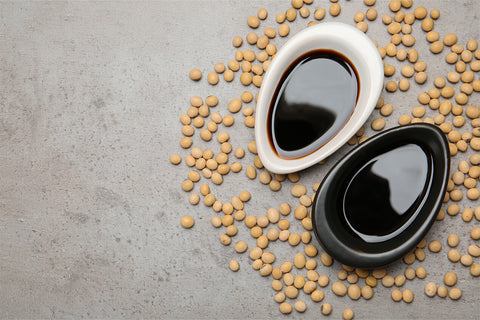
Japanese pickles – known as tsukemono (or, "pickled things") in Japan, are vegetables and fruits that are preserved and served as a side dish or garnish to a larger meal. They are a staple of Japanese culture and cuisine, being their own course in the traditional Japanese tea ceremony.
The Japanese have several words for pickles, of which tsukemono is the most commonly known among Western consumers. Other names you might see referring to Japanese pickles (aside from the individual varieties of pickled fruit and vegetables) include oshinko, konomono, and okōkō. In all these descriptors, the syllable ko (or kō) means fragrant, in reference to the aroma of pickled produce.
Making Tsukemono
While there are different agents one can add to fresh fruit and vegetables, the pickling process itself remains the same for most varieties of tsukemono. To produce Japanese pickles, you need a pickling container (tsukemonoki), salt, an optional pickling agent (which we discuss below) and a pickle stone (tsukemono ishi). These are weights of around 1-2 kilograms that are placed on top of the other ingredients to compress them and ensure they are fully-covered by the salt and the pickling agent.
The tsukemonoki can be made from a range of materials, including wood, plastic, ceramic, or glass, while the tsukemono ishi tend to be made of stone or metal, coated with plastic to prevent contamination of the pickles. While this method is commonly in use for home pickling and some smaller commercial producers, large-scale pickling firms are heavily mechanised, using larger containers and automated screw clamps to apply the necessary pressure.
This form of pickling is known for its short preparation time, comparing to Western pickling techniques, where the ingredients are left to infuse in a pickling liquid for several months.
Soy Sauce Pickles Recipe
Common Pickling Agents
While salt is the standard ingredient for most types of tsukemono, other pickling agents can be added according to preference. These can affect the taste and colour of the resultant pickles, as well as the pickling time. These are some of the most common pickling methods for Japanese pickles:
amasuzuke – sugar and vinegarkarashizuke – hot mustard
kasuzuke – sake kasu
kojizuke – rice koji
misozuke – miso
nukazuke – rice bran
satozuke – sugar
shiozuke – only salt, with no additional pickling agents
shoyuzuke- soy sauce
suzuke – vinegar
Popular Types of Tsukemono
In theory, there is no limit to the types of tsukemono you can produce – so long as the core ingredients of fruit and vegetable are suitable for pickling, you can create any variety. However, there are certain types that are particularly popular in Japan, that you can expect to find on any Japanese menu.
Kyurizuke
Kyurizuke is sliced cucumbers, usually pickled in brine or salt water.
Hakusai
Hakusai is one of the most popular types of tsukemono on the market. Indeed, it is so popular that jars of it are sometimes labelled as tsukemono in Western supermarkets. Hakusai is thick chunks of pickled Chinese cabbage (also known as napa cabbage), as it is regularly served as a side dish.
Hakusai
Beni shōga is a sweet and fragrant form or tsukemono, made by pickling red ginger in umeboshi brine. It is commonly used as a garnish on okonomiyaki (savoury pancakes), takoyaki (octopus balls) and yakisoba (stir-fried noodles).
Rakkyōzuke
Rakkyōzuke is is a pickled onion that is often served alongside Japanese curry and other strongly-flavoured dishes. It has a fresh, mild taste that helps accentuate the more dominant flavour of such meals.
Matsumaezuke
Matsumaezuke is an unusual pickled side-dish, comprising konbu, herring roe (kazunoko), dried squid (surume), ginger, and carrot. These ingredients are pickled in a mixture of mirin, sake, and soy sauce to produce a rich, savoury-sweet pickle.
Fukujinzuke
Another mixed pickle dish, fukujinzuke combines lotus root, aubergine, cucumber, and daikon, pickled using soy sauce. This dish combines tartness with umami notes and is a popular accompaniment to hot and spicy dishes.
Gari
Gari, or pickled ginger, is perhaps the most famous of all Japanese pickles, being frequently used as a garnish or side dish with fresh sushi, cleansing the palate between bites.
View Recipe
Umeboshi
Umeboshi is the name given to pickled Japanese plums (ume), they deliver a powerful salty/sour taste combination and are reputed to cure hangovers.
Takuan
Another traditional tsukemono, takuan is a pickled daikon or mooli radish, and is usually eaten towards the end of the meal as an aid to digestion.
Serving Tsukemono
Tsukemono play a large part in Japanese cuisine, making an appearance at most meals. They can be served as a garnish with a full meal, or smaller dishes, such as sushi. They are also served as snacks (otsumami) alongside drinks, or in larger quantities as a side dish (okazu) to rice. Japanese pickles are also served as a separate course as part of a Japanese tea ceremony – specifically the kaiseki portion.
Popular Products
These are just some of the Japanese pickle products and variations that prove particularly popular at SushiSushi. Click on a link to learn more, or visit our online store for more Japanese pickle products.
Tencho Sushi Ginger
Pickled ginger – or gari – acts as a palate cleanser, often being served with sushi to be eaten between dishes. Tencho sushi ginger is sliced thinly and marinated in vinegar and koji-packed sake lees to impart both sweetness and heat.
Momoya Umeboshi Pickled Plum Paste With Dashi
Umeboshi is the traditional pickled plums, so popular in Japanese cuisine. This delicious paste combines those incredible flavours with the rich umami taste of dashi to create something truly unique. The mix of tangy pickle, umami earthiness, and sweet plum is a great addition to many dishes.
Horaiya, Koji Pickling Liquid
If you’re planning on making your own Japanese pickles at home, you need the right pickling liquid for the job. Horaiya’s Asazuke Shinmi liquid pickling base is rich in koji, produced using centuries-old methods. This fast-acting base can pickle cucumbers, radishes, cabbage, carrots and aubergines in under 30 minutes.
Our Suppliers
Here at SushiSushi, we source our Japanese pickles from some of the most well-respected and established producers in Japan. These include:
Tencho
Tencho create a wide range of Japanese food items and ingredients, but they are best known for their Japanese pickles, which have been a staple of the company since it was founded in 1945. Their main products – including red pickled ginger, scallions, and fukujinzuke – are processed at their factory in Inazawa City, Aichi Prefecture, using domestically grown ingredients.
Horaiya
Horaiya is koji rice malt manufacturer, with a history spanning more than 100 years. They still rely on locally-sourced ingredients and traditional koji production techniques to create fantastic products such as amazake, miso, sagohachi picking base, and more.














